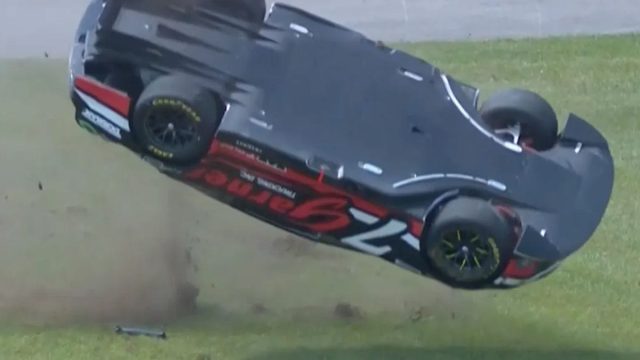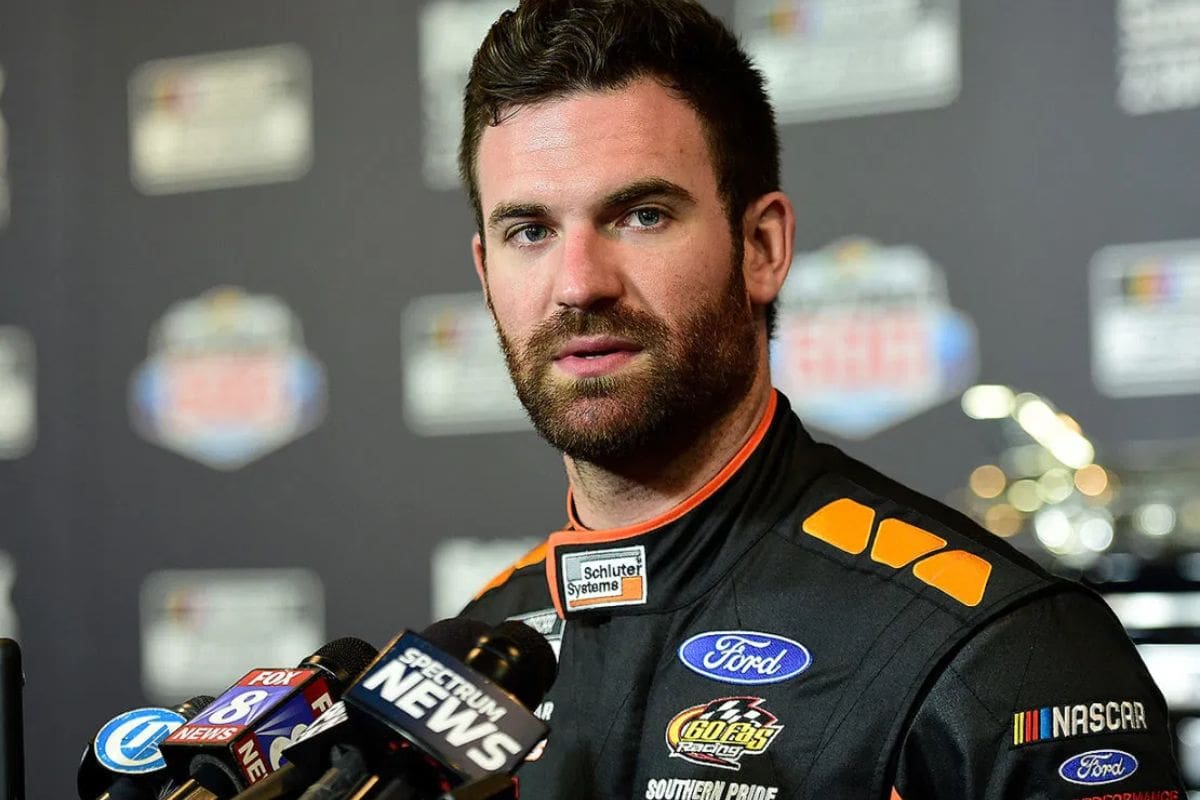Corey LaJoie Shares Terrifying Moments of Michigan Crash: In a frank recounting of his recent crash at Michigan, Corey LaJoie shared the chilling moment he realized he was airborne, capturing the sheer unpredictability of NASCAR racing. The incident, exacerbated by sudden wind gusts, not only tested the limits of his vehicle but also highlighted the psychological strain that accompanies such environments. As LaJoie emerged unscathed, his reflections prompt a deeper examination of the advancements in safety measures within the sport. What implications does this near-disaster have for future races and the evolution of driver safety?
Key Highlights
- Corey LaJoie experienced a terrifying crash at Michigan, describing the moment he realized he was airborne with the phrase, “Oh sh*t, I’m flying.”
- The crash was triggered by strong wind gusts, causing LaJoie’s No. 7 Spire Chevrolet to lose control near the finish line.
- During the incident, LaJoie encountered flying debris, including rocks and dirt, leading to sensory overload and panic.
- Despite the chaos, LaJoie maintained focus by instinctively shutting his visor to protect his eyes from debris.
- LaJoie emerged uninjured, underscoring the effectiveness of NASCAR’s safety protocols and his resilience to return to racing afterward.
Corey LaJoie’s Michigan Crash: A Close Call
In the aftermath of the recent Michigan race, Corey LaJoie’s crash has become a focal point of discussion within the racing community. As LaJoie piloted the No. 7 Spire Chevrolet, he faced an unexpected peril just yards from the finish line. The vehicle, grappling with 25-30 mph gusts of wind, spiraled out of control, leading to a bone-rattling wreck that sent shivers down the spines of spectators and competitors similarly. The moment exemplified the unpredictable nature of motorsport, where the thrill of competition exists in tandem with inherent risks.
The gravity of the incident resonated deeply within the Cup garage, prompting immediate inquiries about LaJoie’s well-being. Fortunately, the driver emerged from the accident unscathed, a demonstration of the rigorous safety protocols that have been implemented in racing. This close call serves as a stark reminder of the fine line between success and disaster in NASCAR.
While LaJoie’s physical health was intact, the psychological impact of such a terrifying experience cannot be underestimated.
As the racing community processes this event, it emphasizes the importance of continuous dialogue about safety advancements and driver preparedness. LaJoie’s experience illuminates the resilience required in the sport, not only to endure such harrowing incidents but also to share them as cautionary tales.
Corey LaJoie’s Detailed Account of the Crash
Corey LaJoie’s initial account of the Michigan crash reveals the intense realities faced by NASCAR drivers. This incident serves as a striking reminder of the inherent dangers of high-speed racing, particularly on a two-mile oval known for its aerodynamic challenges. LaJoie’s harrowing experience emphasizes the split-second decisions and the overwhelming sensations that come with racing at such velocities.
Then it picked up and I was like, ‘Oh s**t, I’m flying through the air.’ There’s like rocks and dust and dirt…My eyes are closed ’cause of the stuff, sparks, and stuff hitting me in the face. I’m like, ‘Why am I getting stuff in my eye here? Oh, my visor’s open.’ So I shut my visor.” – LaJoie
- The moment of impact: LaJoie attempted to overtake Noah Gragson but found himself losing control.
- Sudden elevation: He described the chilling realization, “Oh sh*t, I’m flying through the air.”
- Physical chaos: Surrounding debris—rocks, dust, and dirt—engulfed him during the flight.
- Sensory overload: Sparks and other materials struck him in the face, prompting panic.
- Protective measures: He instinctively shut his visor to shield his eyes from the onslaught.
"Oh ****, I'm flying through the air."@CoreyLaJoie describes his accident yesterday at @MISpeedway. pic.twitter.com/Tc2lBVNuM9
— NASCAR (@NASCAR) August 20, 2024
LaJoie’s frank recollection captures the frightening essence of racing; it is not merely a sport but a test of human endurance under extreme conditions. The adrenaline rush, combined with the fear of the unknown, can transform a routine lap into a life-threatening ordeal in mere moments.
LaJoie’s Struggle During the Crash
The chaotic nature of LaJoie’s struggle during the crash encapsulates the unpredictable challenges NASCAR drivers face at high speeds. In the face of an impending disaster, LaJoie exhibited remarkable presence of mind. As he hit the wall upside down, his immediate instinct was to protect his vision and secure himself within the vehicle. “Oh, shoot. I’m still going pretty fast, let me grab my seatbelts,” he recalled, emphasizing the urgency of the situation.
While grappling with the dizzying dynamics of the wreck, LaJoie encountered an unexpected element: a sizable clump of grass that landed on his lap. His quick reflexes kicked in as he managed to retrieve the grass and clear his vision amidst the chaos. “I had dirt in my eyes and stuff all over,” he noted, illustrating the sensory overload that compounded his struggle.
“Holding my visor like this, I hit the wall upside down and the wheel rips out of my hand. I’m like, ‘Oh, shoot. I’m still going pretty fast, let me grab my seatbelts.’ Then I got to the grass…Then a freaking…bigger than a softball-sized clump of grass landed right on my lap…I picked it up. I had dirt in my eyes and stuff all over, and I just like flipped it to the right side of the car.” – LaJoie
The physical and psychological toll of such events often lingers long after the crash, yet LaJoie emerged relatively unscathed. His affirmation, “I’m doing fine,” speaks volumes about his resilience and the rigorous safety standards of NASCAR’s NextGen car.
“Safe cars, kudos to NASCAR. I would jump back in if they’d let me.” – LaJoie
The contrast between the harrowing experience he faced and his readiness to return to racing highlights the intricate balance of adrenaline and danger that defines NASCAR. LaJoie’s account serves not only as a personal narrative but also as a reflection of the relentless spirit of a driver who welcomes the risk inherent in the sport.
Evolution of Safety in NASCAR
Safety in NASCAR has undergone a remarkable transformation over the past two decades, driven by a commitment to protecting drivers amid the inherent dangers of high-speed racing. The tragic death of Dale Earnhardt in 2001 served as a catalyst for sweeping changes, prompting NASCAR to prioritize driver safety like never before.
The advancements made since then have considerably mitigated risks associated with crashes, allowing drivers like Ryan Preece and Corey LaJoie to emerge relatively unscathed from harrowing incidents.
“I’ve seen other interviews from drivers in the past that as you get sideways and as you go in the air, it’s gets real quiet.”
“After experiencing that, that’s 100% true. Beyond that, everything’s happening so fast, you’re just flipping through the air. Until that ride stops, all you’re thinking about is just trying to contain yourself. You tense up and you hope you’re going to be OK, which obviously I am.” – Preece
Key developments in NASCAR safety include:
- SAFER Barriers: Implementation of Steel And Foam Energy Reduction barriers to absorb impact energy during collisions.
- HANS Devices: Mandatory use of Head and Neck Support devices to prevent whiplash and severe head injuries.
- Improved Cockpit Design: Enhanced cockpit structures designed to withstand greater forces while protecting drivers during rollovers and impacts.
- Fire-Resistant Suits: Mandatory fire-retardant racing suits and helmets to reduce burn injuries in case of fires.
- Medical Protocols: Improved medical response protocols and on-site medical teams ready to assist after crashes.
These measures have redefined the landscape of safety in NASCAR, fostering an environment where drivers can compete with increased confidence.
The experiences of contemporary drivers affirm the effectiveness of these advancements, highlighting the crucial role safety plays in preserving lives and improving the sport’s integrity.
Corey LaJoie’s Future and Legacy
As the sun sets on his current season in NASCAR, Corey LaJoie’s adventure is far from over, regardless of whether he returns to the Cup Series next year. His quest, marked by resilience and resolve, has cemented his place as a memorable figure in the sport. LaJoie’s frank reflections on high-stakes moments, such as his harrowing crash at Michigan, reveal not only his bravery but also his commitment to the sport’s evolution, particularly in safety innovations.
While speculation surrounds his future in the Cup Series, the essence of LaJoie’s legacy transcends a singular racing path. He embodies the spirit of perseverance that resonates with fans and aspiring drivers similarly. His ability to connect with audiences through social media and open interviews has established him as an influential voice in NASCAR, promoting both safety awareness and mental fortitude.
Should LaJoie’s racing career take a different path, he possesses the potential to impact the sport beyond the track. His insights into driver safety and experiences on the circuit can foster discussions that lead to additional advancements in NASCAR’s safety protocols.
Ultimately, whether in the cockpit or on the sidelines, Corey LaJoie’s story will continue to inspire and shape NASCAR’s narrative, ensuring his legacy is not solely defined by his finishes but by the lives he touches along the way.
News in Brief: Corey LaJoie Shares Terrifying Moments of Michigan Crash
The harrowing experience of Corey LaJoie’s crash at Michigan emphasizes the unpredictable nature of motorsport and the critical importance of advanced safety measures. LaJoie’s ability to emerge unscathed highlights not only the effectiveness of NASCAR’s safety protocols but also the resilience required of drivers in such environments. As the sport continues to evolve, the lessons learned from such incidents will certainly shape future safety innovations, ensuring that driver protection remains a paramount concern in NASCAR.
ALSO READ: Denny Hamlin on Corey LaJoie’s Car Flip: “I’d Rather Roll Over”



